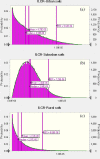Source identification and toxicity apportionment of polycyclic aromatic hydrocarbons in surface soils in Beijing and Tianjin using a PMF-TEQ method
- PMID: 35771809
- PMCID: PMC9246166
- DOI: 10.1371/journal.pone.0268615
Source identification and toxicity apportionment of polycyclic aromatic hydrocarbons in surface soils in Beijing and Tianjin using a PMF-TEQ method
Abstract
Beijing and Tianjin are two of the largest cities in northern China with high population densities and highly developed manufacturing industries. In the past decade, some authors have reported their PAH concentrations in surface soils, identified their sources and quantitatively reported their health risks. However, the contributions of different PAH sources to their toxicity have not been reported thus far. In this study, we reviewed the PAH concentrations, contributions of different sources to the toxicity, and cancer risks in soils from different land use types found within Beijing and Tianjin from data gathered by 41 studies. The total PAH concentration varied in the range of 175.7-1989.0 ng g-1 with a higher median PAH concentration detected in urban soils (789.7 ng g-1), followed by suburban soils (647.3 ng g-1) and rural soils (390.8 ng g-1). Source identification using diagnostic ratios and principal component analysis (PCA) suggested that the PAHs in all three land use types mainly originated from biomass and coal combustion, vehicular emissions, and petrogenic processes with contributions varying from 13% to 62%. Furthermore, results from a positive matrix factorization (PMF) model suggested that vehicular emissions and coal combustion in urban soils, and the vehicular emissions, coal combustion and biomass combustion in suburban and rural soils dominated the total PAH concentrations (>85%). These results were consistent with those of the PCA model. Results of the additional toxicity apportionment performed using the PMF model suggested that vehicular emissions and coal combustion contributed the most to the toxic equivalent quantity for Benzo(a)Pyrene (BaPTEQ) and, by extension, to the carcinogenic potencies. The incremental lifetime cancer risk (ILCR) values suggested a low risk level for adults exposed to PAHs in the different land use types found within Beijing and Tianjin.
Conflict of interest statement
The authors declare that they have no known competing financial interests or personal relationships that could have appeared to influence the work reported in this paper.
Figures




Similar articles
-
Occurrence, characteristics and sources of polycyclic aromatic hydrocarbons in arable soils of Beijing, China.Ecotoxicol Environ Saf. 2018 Sep 15;159:120-126. doi: 10.1016/j.ecoenv.2018.04.069. Epub 2018 May 4. Ecotoxicol Environ Saf. 2018. PMID: 29734067
-
Polycyclic aromatic hydrocarbons associated with total suspended particles and surface soils in Kunming, China: distribution, possible sources, and cancer risks.Environ Sci Pollut Res Int. 2015 May;22(9):6696-712. doi: 10.1007/s11356-014-3858-8. Epub 2014 Nov 26. Environ Sci Pollut Res Int. 2015. PMID: 25422115
-
Polycyclic aromatic hydrocarbons (PAHs) in urban soils of the megacity Shanghai: occurrence, source apportionment and potential human health risk.Sci Total Environ. 2013 Mar 1;447:80-9. doi: 10.1016/j.scitotenv.2012.12.086. Epub 2013 Jan 31. Sci Total Environ. 2013. PMID: 23376519
-
Spatial distribution of polycyclic aromatic hydrocarbon contamination in urban soil of China.Chemosphere. 2019 Sep;230:498-509. doi: 10.1016/j.chemosphere.2019.05.006. Epub 2019 May 11. Chemosphere. 2019. PMID: 31125878 Review.
-
Source apportionment and toxicity assessment of PM2.5-bound PAHs in a typical iron-steel industry city in northeast China by PMF-ILCR.Sci Total Environ. 2020 Apr 15;713:136428. doi: 10.1016/j.scitotenv.2019.136428. Epub 2020 Jan 13. Sci Total Environ. 2020. PMID: 32019009 Review.
Cited by
-
Vehicular mediated emissions of polycyclic aromatic hydrocarbons in roadside soils of Shanghai.Sci Rep. 2025 Mar 31;15(1):10981. doi: 10.1038/s41598-025-93715-w. Sci Rep. 2025. PMID: 40164670 Free PMC article.
References
-
- Thiombane M, Albanese S, Di Bonito M, Lima A, Zuzolo D, Rolandi R, et al.. Source patterns and contamination level of polycyclic aromatic hydrocarbons (PAHs) in urban and rural areas of Southern Italian soils. Environ Geochem Hlth. 2019;230: 927–935. - PubMed
-
- Mohit A, Keshavarzi B, Moore F. Polycyclic aromatic hydrocarbons (PAHs) in urban soils of Ahvaz metropolis; contamination, composition, distribution, potential sources, and cancer risk. Hum Ecol Risk Assess. 2019;25: 935–948.
Publication types
MeSH terms
Substances
LinkOut - more resources
Full Text Sources
Medical
Miscellaneous

